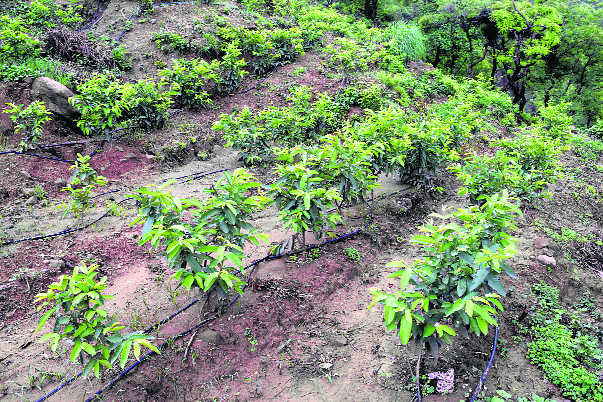
One-year-old guava plants.
Ambika Sharma
Dwelling on the principle of “maximum sunlight maximum yield,” new technological interventions being undertaken by scientists at the Neri-based All- India Coordinated Research Project (AICRP) centre will ensure that mango crop was grown at the height of a brinjal plant.
The Principal Investigator, Dr Som Dev Sharma, while elaborating on the centre said under the new skilled-canopy management technique, plants are supposed to be grown at a height of 2.5 metres by following the requisite techniques because it helps give the maximum exposure to sunlight to enhance yield. Since mango is a non-profitable crop, such interventions will help enhance its profitability.
Other interventions like introducing later varieties, which will be ready for harvesting by August and September will fetch more profitable results and these will also be introduced after successful farm demonstrations.
Efforts are also afoot to reduce the farm cost of weed management as well as introduction of optimum use of fertiliser in accordance with the growth state because they can bring down the input cost by as much as 30 to 40 per cent by reducing the farm- labour cost.
He said since the size of land holdings was smaller in Himachal vis-a-vis Haryana and Punjab, they were trying to harness the seasonal advantage by introducing such techniques.
This centre which will undertake research on mango, litchi and guava will strengthen research and development activities on subtropical fruits grown in Himachal Pradesh, which offer a big scope for expansion but have failed to make a big impact in the national scenario. About 50 such centres are spread all across the country in various zones.
Sharma said the major focus of the project was to devise interventions, which would help double farm income. It was a long-term project which will work on releasing new varieties, validating the existing technologies as well as their demonstration.
He said they were trying to develop at least 50 new varieties of these fruits as well as conduct validation of other varieties developed by the other centres. New technological intervention like high-density farming, optimum use of fertiliser in accordance with the growth stage of a plant and skilled-canopy management were some of the aspects, which were being addressed through this centre. Once the new technology and variety is validated, it will be recommended for production in various regions across the nation.
He added the centre will standardise new technologies like architectural engineering for canopy management and ultra-high and high-density planting. The project will also work on customised fertiliser, precision-farming technologies and testing and validation of technologies developed by different national research centres for suitability in the state.
A team of scientists from Fruit Science, Soil Science, Entomology and Plant Pathology will devise location-specific modules and conduct research on insect-pest and disease management. In the first year, more than 50 promising hybrids/varieties of mango, guava and litchi will be evaluated and 15 experiments to address crop production and pest management problems will be carried out.
Since farming is rainfed, the productivity of cereals in subtropics is less than 1.5 tonnes per/ha, which is quite low as compared to the adjoining states. The farmers of the region are practising only subsistence farming. However, there is a vast scope for commercial farming through horticulture crops, which generates more employment and net returns. The productivity of subtropical fruits in the state is less than one tonne per/ha, which is quite low as compared to the national average of 12 tonnes per/ha.
“This is a big achievement for the university and the state. The centre will go a long way in transforming the cropping pattern from subsistence to commercial horticulture, and, in turn, improve the economy of the region,” said Sharma.



























